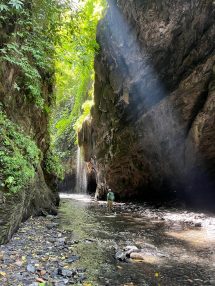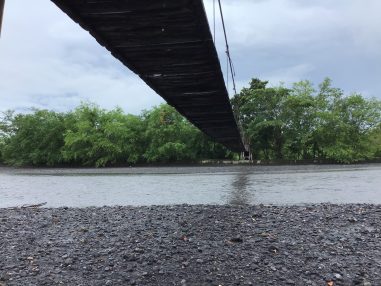Background


Left) suspension bridge in Puerto Romero, Colombia, where we crossed to collect sample from the other side. Right) La Cristalina Canyon of Cretaceous shales. (Photography by Jack Konguthaithip)
The laser ablation system will be utilized based on the conditions from a previous study by Yuan et al. (2004) and Yuan et al. (2008). The analytical sequences of zircons analyses are based on the external standard calibration method and template used in Arizona LaserChron (Pullen et al., 2018). The expected internal standard calibration is Si elemental signals to correct for the systematic shift of elemental and isotopic signals. The primary external standard, FC-1, of known U-Pb age will be used for U-Pb fractionation measurement. We also plan to use Dynamic Reaction Cell with ICP-MS to increase resolution and signals of both U-Pb and REEs accurate. The operating conditions of the laser ablation and mass spectrometer will be based on the set up used in Yuan et al. (2004)
The Colombian Eastern Cordillera lies in a tectonically active zone and crustal deformation to the easternmost orogenic belts in western Colombia since Jurassic to Cretaceous. One of the key evidences that facilitate the geologic history interpretation is the detrital zircon provenances signatures recorded in sedimentary units within the deformed crustal sheets. In the Eastern Cordillera, one of the earliest record of contractional deformation is the regional unconformity overlying the transitional marine deposit (Puerto Romero formation). Thus, the significant of this study is to define the provenance signatures predating the regional deformation or crustal shortening in the Eastern Cordillera. The preliminary U-Pb detrital zircons geochronology shows that the detrital zircons population within the sample (23ROM27) from Puerto Romero formation include a wide range of age distributions from Precambrian to Cenozoic.
Ultimately, we are interested in examining the sedimentary provenance through the use of detrital zircons from sedimentary rocks, so we can constrain the preferential sedimentary source of the Middle Magdalena Valley, Colombia. In other words, which of the two cordilleras is feeding the valley? Is it the Eastern Cordillera or the Central Cordillera, or a mix of both? Is one cordillera depositing more sediments than the other, or in equal amounts? Adding on, these sedimentary provenances can also allude to temporal variabilities such as when were these two cordilleras depositing sediments into the valley. We will be examining the sedimentary provenance of the Middle Magdalena Valley using the U-Th-Pb isotopic system in detrital zircons, in which both U-238 and Th-232 decay to Pb-206 and Pb-208, respectively (Gehrels, 2010).
The first trace elements system we are interested in is the geochemical signature Sr/Y to examine the crustal thickness variations below the Eastern and Central Cordillera and compare their differences (Chapman et al., 2015). Perhaps one of the cordilleras has a thicker crustal root or is more exhumed than the other due to the subduction of the Caribbean plate. For future work, these crustal thickness variations can be tied to thermochronology, either U-Th/He or fission tracks where we can examine the exhumation rates of these magmatic arcs as one arc might preferentially exhume at a faster rate due its interaction, or lack thereof, with the subducting Caribbean plate.
Similarly, the Rare Earth Elements (REEs) series are unique trace elements to the geological setting with unique initial conditions for crystallization and partition in heavy minerals such as zircon and apatite. REEs have the ability to determine continental crust magma generation phases. Thus, we should be able to see an enrichment in incompatible elements in our samples due to their theorized origin (magmatic arc). A key REE in the lanthanide series that can verify the generation of our samples in upper continental crust is the Eu2+ anomaly. Eu2+ preferentially fractionates in plagioclase above 10-12 kbar, and becomes unstable below this pressure range, thus constraining the melt to upper continental crust in origin if the anomaly is present (Taylor and McClennan, 1981). Adding on, another trace element that provide critical information to the origin of the magmatic arcs in the Central and Eastern Coridlleras of Colombia is Hf. Epsilon Hf (εHf) can be used to determine the source of melt that is supplying the magmatism in the magmatic arc (Chapman & Ducea, 2019).
Another parameter that is important in our analysis is Th/U. A log(Th/U) ratio < -1 is indicative of zircons formed in a metamorphic fluid at high pressures and > – 1 suggests zircons of igneous origin (Rubatto, 2002). Th/U is important because we need to verify that our zircons are igneous in origin in order to analyze the Rare Earth Elements relative to Cl Chondrite (McDonough & Sun, 1985). Adding on, Th/U is also important to distinguish between metamorphic zircons and igneous zircons because REEs in both zircons exhibit Ce anomaly, Eu anomaly, high Y, P, and Hf (Rubatto, 2002). Data collection for Th/U occurred at Arizona LaserChron Center using a Thermo Scientific E2 single-collector LA-ICP-MS and followed the methods in Pullen et al., (2018).